Cape Verde
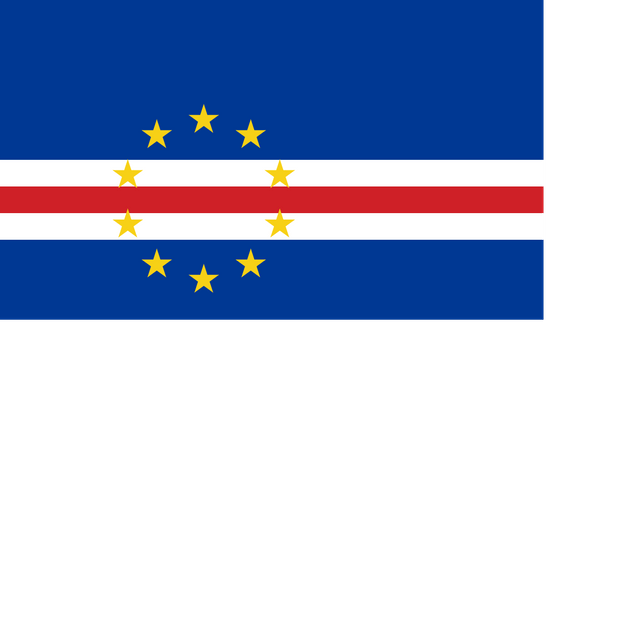
Cape Verde

Republic of Cabo Verde | |
|---|---|
Motto:
| |
**Anthem:**Cântico da Liberdade(Portuguese) Chant of Freedom | |
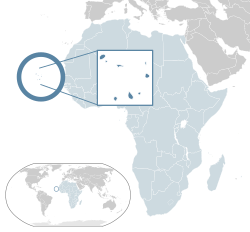 Location of Cape Verde (dark blue)– in Africa (light blue & dark grey) – in the African Union (light blue) | |
| Capital and largest city | Praia 14°55′N 23°31′W [90] |
| Official languages | Portuguese[1] |
| Recognised national languages | Cape Verdean Creole[1] |
| Demonym(s) | Cape Verdean or Cabo Verdean[2] |
| Government | Unitary semi-presidentialrepublic[3] |
• President | Jorge Carlos Fonseca |
• Prime Minister | Ulisses Correia e Silva |
| Legislature | National Assembly |
| Formation | |
• Discovery | 1460 |
• Independence from Portugal | 5 July 1975 |
• Multi-party system | 13 January 1990 |
| Area | |
• Total | 4,033 km2(1,557 sq mi) (166th) |
• Water (%) | negligible |
| Population | |
• 2016 estimate | 539,560[4] (167th) |
• Density | 123.7/km2(320.4/sq mi) (89th) |
| GDP(PPP) | 2019 estimate |
• Total | $4.323 billion |
• Per capita | $7,728[5] |
| GDP(nominal) | 2019 estimate |
• Total | $2.042 billion |
• Per capita | $3,651[5] |
| Gini(2008) | 47.2[6] high |
| HDI(2017) | medium · 125th |
| Currency | Cape Verdean escudo (CVE) |
| Time zone | UTC-1(CVT) |
• Summer (DST) | UTC-1(not observed) |
| Driving side | right |
| Calling code | +238 |
| ISO 3166 code | CV |
| Internet TLD | .cv |
Cape Verde (/ˈvɜːrd(i)/ (listen)) or Cabo Verde (/ˌkɑːboʊ ˈvɜːrdeɪ/ (listen), /ˌkæb-/) (Portuguese: Cabo Verde, pronounced [ˈkabu ˈveɾdɨ]), officially the Republic of Cabo Verde,[9] is an island country spanning an archipelago of 10 volcanic islands in the central Atlantic Ocean. It forms part of the Macaronesia ecoregion, along with the Azores, Canary Islands, Madeira, and the Savage Isles. In ancient times these islands were referred to as "the Islands of the Blessed" or the "Fortunate Isles". Located 570 kilometres (350 mi) west of the Cape Verde Peninsula off the coast of Northwest Africa, the islands cover a combined area of slightly over 4,000 square kilometres (1,500 sq mi).
The Cape Verde archipelago was uninhabited until the 15th century, when Portuguese explorers discovered and colonized the islands, establishing the first European settlement in the tropics. Ideally located for the Atlantic slave trade, the islands grew prosperous throughout the 16th and 17th centuries, attracting merchants, privateers, and pirates. The end of transatlantic slavery in the 19th century led to economic decline and emigration. Cape Verde gradually recovered as an important commercial center and stopover for shipping routes. Incorporated as an overseas department of Portugal in 1951, the islands continued to campaign for independence, which was achieved in 1975.
Since the early 1990s, Cape Verde has been a stable representative democracy, and remains one of the most developed and democratic countries in Africa. Lacking natural resources, its developing economy is mostly service-oriented, with a growing focus on tourism and foreign investment. Its population of around 540,000 is mostly of mixed European, Moorish, Arab and African heritage, and predominantly Roman Catholic, reflecting the legacy of Portuguese rule. A sizeable diaspora community exists across the world, slightly outnumbering inhabitants on the islands.
Historically, the name "Cape Verde" has been used in English for the archipelago and, since independence in 1975, for the country. In 2013, the Cape Verdean government determined that the Portuguese designation Cabo Verde would henceforth be used for official purposes, as at the United Nations, even in English contexts. Cape Verde is a member of the African Union.
Republic of Cabo Verde | |
|---|---|
Motto:
| |
**Anthem:**Cântico da Liberdade(Portuguese) Chant of Freedom | |
 Location of Cape Verde (dark blue)– in Africa (light blue & dark grey) – in the African Union (light blue) | |
| Capital and largest city | Praia 14°55′N 23°31′W [90] |
| Official languages | Portuguese[1] |
| Recognised national languages | Cape Verdean Creole[1] |
| Demonym(s) | Cape Verdean or Cabo Verdean[2] |
| Government | Unitary semi-presidentialrepublic[3] |
• President | Jorge Carlos Fonseca |
• Prime Minister | Ulisses Correia e Silva |
| Legislature | National Assembly |
| Formation | |
• Discovery | 1460 |
• Independence from Portugal | 5 July 1975 |
• Multi-party system | 13 January 1990 |
| Area | |
• Total | 4,033 km2(1,557 sq mi) (166th) |
• Water (%) | negligible |
| Population | |
• 2016 estimate | 539,560[4] (167th) |
• Density | 123.7/km2(320.4/sq mi) (89th) |
| GDP(PPP) | 2019 estimate |
• Total | $4.323 billion |
• Per capita | $7,728[5] |
| GDP(nominal) | 2019 estimate |
• Total | $2.042 billion |
• Per capita | $3,651[5] |
| Gini(2008) | 47.2[6] high |
| HDI(2017) | medium · 125th |
| Currency | Cape Verdean escudo (CVE) |
| Time zone | UTC-1(CVT) |
• Summer (DST) | UTC-1(not observed) |
| Driving side | right |
| Calling code | +238 |
| ISO 3166 code | CV |
| Internet TLD | .cv |
Etymology
The name of the country stems from the nearby Cap-Vert, on the Senegalese coast.[10] In 1444, Portuguese explorers had named that landmark as Cabo Verde, a few years before they discovered the islands (Verde is Portuguese for "green").
History

Insulae Capitis Viridis (1598), showing Cape Verde
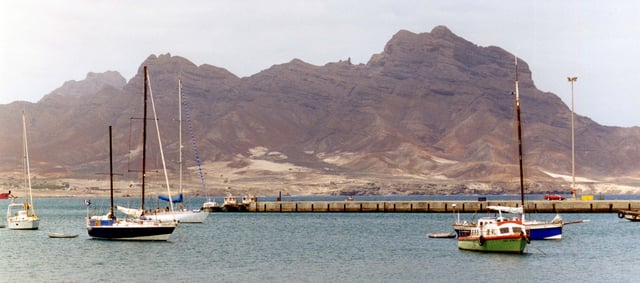
A view of Monte Cara from Mindelo
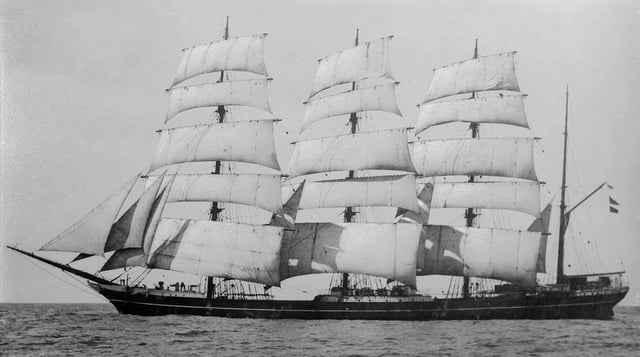
Grain ship Garthpool, wrecked at Boavista, Cape Verde, in 1928
Before the arrival of Europeans, the Cape Verde Islands were uninhabited.[12] They were discovered by Genoese and Portuguese navigators around 1456. According to Portuguese official records,[13] the first discoveries were made by Genoa-born António de Noli, who was afterwards appointed governor of Cape Verde by Portuguese King Afonso V. Other navigators mentioned as contributing to discoveries in the Cape Verde archipelago are Diogo Gomes (who was with António de Noli and claimed to have been the first to land on and name Santiago island), Diogo Dias, Diogo Afonso and the Italian (Venice-born) Alvise Cadamosto.
In 1462, Portuguese settlers arrived at Santiago and founded a settlement they called Ribeira Grande (now called Cidade Velha ("Old City"), to avoid being confused with the town of Ribeira Grande on the Santo Antão island). Ribeira Grande was the first permanent European settlement in the tropics.[14]
In the 16th century, the archipelago prospered from the Atlantic slave trade.[14] Pirates occasionally attacked the Portuguese settlements. Francis Drake, an English privateer, twice sacked the (then) capital Ribeira Grande in 1585 when it was a part of the Iberian Union.[14] After a French attack in 1712, the town declined in importance relative to nearby Praia, which became the capital in 1770.[14]
Decline in the slave trade in the 19th century resulted in an economic crisis. Cape Verde's early prosperity slowly vanished. However, the islands' position astride mid-Atlantic shipping lanes made Cape Verde an ideal location for re-supplying ships. Because of its excellent harbour, the city of Mindelo, located on the island of São Vicente, became an important commercial centre during the 19th century.[14] Diplomat Edmund Roberts visited Cape Verde in 1832.[15]. Cape Verde was the first stop of Charles Darwin's voyage with HMS Beagle in 1832.[16]
With few natural resources and inadequate sustainable investment from the Portuguese, the citizens grew increasingly discontented with the colonial masters, who nevertheless refused to provide the local authorities with more autonomy. In 1951, Portugal changed Cape Verde's status from a colony to an overseas province in an attempt to blunt growing nationalism.
In 1956, Amílcar Cabral and a group of fellow Cape Verdeans and Guineans organised (in Portuguese Guinea) the clandestine African Party for the Independence of Guinea and Cape Verde (PAIGC).[14] It demanded improvement in economic, social and political conditions in Cape Verde and Portuguese Guinea and formed the basis of the two nations' independence movement. Moving its headquarters to Conakry, Guinea in 1960, the PAIGC began an armed rebellion against Portugal in 1961. Acts of sabotage eventually grew into a war in Portuguese Guinea that pitted 10,000 Soviet Bloc-supported PAIGC soldiers against 35,000 Portuguese and African troops.[14]
By 1972, the PAIGC controlled much of Portuguese Guinea despite the presence of the Portuguese troops, but the organization did not attempt to disrupt Portuguese control in Cape Verde. Portuguese Guinea declared independence in 1973 and was granted de jure independence in 1974. A budding independence movement — originally led by Amílcar Cabral, assassinated in 1973 — passed on to his half-brother Luís Cabral and culminated in independence for the archipelago in 1975.
Independence (1975)

Amílcar Cabral on a stamp of the former East Germany
Following the April 1974 revolution in Portugal, the PAIGC became an active political movement in Cape Verde. In December 1974, the PAIGC and Portugal signed an agreement providing for a transitional government composed of Portuguese and Cape Verdeans. On 30 June 1975, Cape Verdeans elected a National Assembly which received the instruments of independence from Portugal on 5 July 1975.[14] In the late 1970s and 1980s, most African countries prohibited South African Airways from overflights but Cape Verde allowed them and became a centre of activity for the airline's flights to Europe and the United States.
Immediately following the November 1980 coup in Guinea-Bissau, relations between Cape Verde and Guinea-Bissau became strained. Cape Verde abandoned its hope for unity with Guinea-Bissau and formed the African Party for the Independence of Cape Verde (PAICV). Problems have since been resolved and relations between the countries are good. The PAICV and its predecessor established a one-party system and ruled Cape Verde from independence until 1990.[14]
Responding to growing pressure for pluralistic democracy, the PAICV called an emergency congress in February 1990 to discuss proposed constitutional changes to end one-party rule. Opposition groups came together to form the Movement for Democracy (MPD) in Praia in April 1990. Together, they campaigned for the right to contest the presidential election scheduled for December 1990.
The one-party state was abolished 28 September 1990, and the first multi-party elections were held in January 1991. The MPD won a majority of the seats in the National Assembly, and MPD presidential candidate António Mascarenhas Monteiro defeated the PAICV's candidate with 73.5% of the votes. Legislative elections in December 1995 increased the MPD majority in the National Assembly. The party won 50 of the National Assembly's 72 seats.
A February 1996 presidential election returned President Monteiro to office. Legislative elections in January 2001 returned power to the PAICV, with the PAICV holding 40 of the National Assembly seats, MPD 30, and Party for Democratic Convergence (PCD) and Labour and Solidarity Party (PTS) 1 each. In February 2001, the PAICV-supported presidential candidate Pedro Pires defeated former MPD leader Carlos Veiga by only 13 votes.[14]
Politics
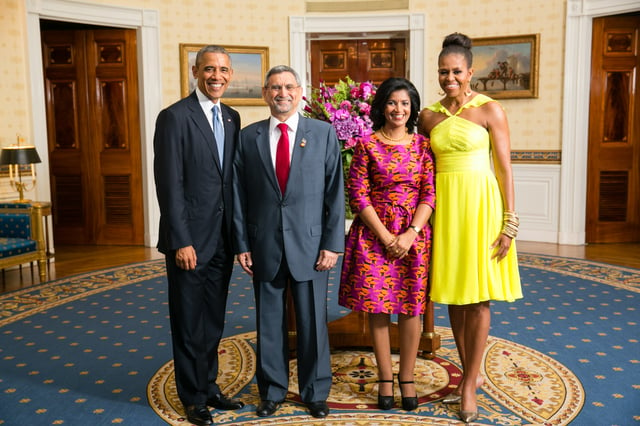
Cape Verdean President Jorge Carlos Fonseca and Ligia Fonseca meet with the US President Barack Obama and Michelle Obama in 2014.
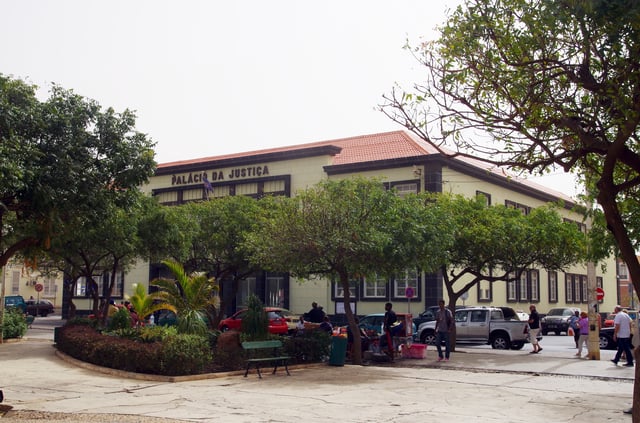
Palácio da Justiça - Palace of Justice, in Praia
Cape Verde is a stable semi-presidential representative democratic republic.[3][17] It is among the most democratic nations in Africa, ranking 26th in the world, according to the 2018 Democracy Index.[18] The constitution [91] — adopted in 1980 and revised in 1992, 1995 and 1999 — defines the basic principles of its government. The president is the head of state and is elected by popular vote for a 5-year term.[14]
The prime minister is the head of government and proposes other ministers and secretaries of state. The prime minister is nominated by the National Assembly and appointed by the president. Members of the National Assembly are elected by popular vote for 5-year terms. Three parties now hold seats in the National Assembly — MPD (36), PAICV (25) and the Cape Verdean Independent Democratic Union (UCID) (3).[19]
The judicial system consists of a Supreme Court of Justice — whose members are appointed by the president, the National Assembly, and the Board of the Judiciary — and regional courts. Separate courts hear civil, constitutional, and criminal cases. Appeal is to the Supreme Court.[14]
The two main political parties are PAICV and MPD.[19]
Foreign relations

Map of countries with Cape Verdean embassies
Cape Verde follows a policy of nonalignment and seeks cooperative relations with all friendly states.[14] Angola, Brazil, China, Libya, Cuba, France, Germany, Portugal, Spain, Senegal, Russia, Luxembourg, and the United States maintain embassies in Praia.[14] Cape Verde is actively interested in foreign affairs, especially in Africa.[14]
Cape Verde is a founding member state of the Community of Portuguese Language Countries (CPLP), also known as the Lusophone Commonwealth, and international organization and political association of Lusophone nations across four continents, where Portuguese is an official language.
Cape Verde has bilateral relations with some Lusophone nations and holds membership in a number of international organisations.[14] It also participates in most international conferences on economic and political issues.[14] Since 2007, Cape Verde has a special partnership status[20] with the EU, under the Cotonou Agreement, and might apply for special membership, even because the Cape Verdean escudo, the country's currency, is indexed to the Euro.[21] In 2011 Cape Verde ratified the Rome Statute of the International Criminal Court.[22] In 2017 Cape Verde signed the UN treaty on the Prohibition of Nuclear Weapons.[23]
Military
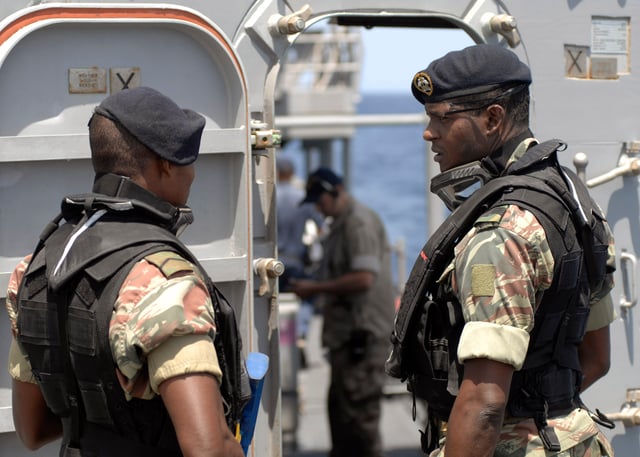
Marines of the Cape Verdean Coast Guard
The military of Cape Verde consists of the National Guard and the Coast Guard; 0.7% of the country's GDP was spent on the military in 2005.
Having fought their only war for independence against Portugal between 1974 and 1975, the efforts of the Caboverdean Armed Forces have now been turned to combating international drug trafficking. In 2007, together with the Cape Verdean Police, they carried out Operation Flying Launch (Operacão Lancha Voadora), a successful operation to put an end to a drug trafficking group which smuggled cocaine from Colombia to the Netherlands and Germany using the country as a reorder point. The operation took more than three years, being a secret operation during the first two years, and ended in 2010.
Although located in Africa, Cape Verde has always had close relations with Europe. Because of this, some scholars argue that Cape Verde may be eligible to join the Organization for Security and Co-operation in Europe and NATO.[24]
The most recent engagement of the Armed Forces was the Monte Tchota massacre that resulted in 11 deaths.[25]
International recognition
Cape Verde is often praised as an example among African nations for its stability and developmental growth despite its lack of natural resources. In 2013 then United States President Barack Obama said Cape Verde is "a real success story".[26] Among other achievements, it has been recognised with the following assessments:
| Index | Score | PALOP rank | CPLP rank | African rank | World rank | Year |
|---|---|---|---|---|---|---|
| Human Development Index | 0.654 | 1(top 17%) | 3(top 38%) | 10(top 19%)[A] | 125(top 62%) | 2017[7] |
| Ibrahim Index of African Governance | 71.1 | 1(top 17%) | N/A | 3(top 6%) | N/A | 2018[27] |
| Freedom of the Press | 27 (Free) | 1(top 17%) | 2(top 25%) | 1(top 2%) | 48(top 24%) | 2014 |
| Freedom in the World | 1/1[B] | 1(top 17%) | 1(top 13%)[C] | 1(top 2%)[D] | 1(top 1%)[E] | 2016 |
| Press Freedom Index | 18.02 | 1(top 17%) | 2(top 25%) | 3(top 6%) | 27(top 14%) | 2017 |
| Democracy Index | 7.88(Flawed democracy) | 1(top 17%) | 1(top 13%) | 2(top 4%) | 26(top 13%) | 2018 |
| Corruption Perceptions Index | 59 | 1(top 17%) | 2(top 25%) | 2(top 4%) | 38(top 19%) | 2016 |
| Index of Economic Freedom[28] | 66.5 | 1(top 17%) | 1(top 13%) | 3(top 6%) | 57(top 28%) | 2016 |
| e-Government Readiness Index | 0.3551 | 1(top 17%) | 3(top 38%) | 14(top 26%) | 127(top 63%) | 2014 |
| Failed States Index | 74.1 | 1(top 17%) | 3(top 38%) | 8(top 15%) | 93(top 46%)[F] | 2014 |
| Networked Readiness Index | 3.8 | 1(top 17%) | 3(top 38%) | 7(top 13%) | 87(top 43%) | 2015[29] |
| ASee List of countries by Human Development Index#Africa |
| B1/1 is the highest possible rating. |
| CWith the maximum score, Cape Verde shares the first place with Portugal. |
| DCape Verde was the only African country to reach the maximum rating. |
| EWith the maximum score, Cape Verde shares the first place with 48 other countries. |
| FThe rank on this list is expressed in reverse order. To be comparable with the other rankings on this table, the actual rank of 88 was inverted, by subtracting it from the number of countries on the list, currently 177. |
Geography

A topographic map of Cape Verde
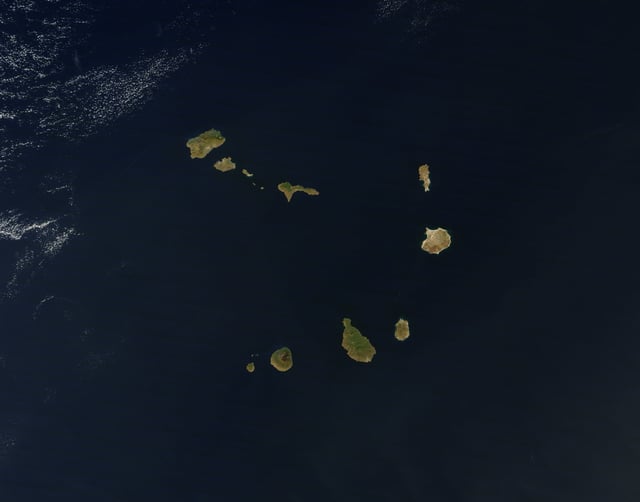
A satellite photo of the Cape Verde islands, 2010

The beach of Calhau, with Monte Verde in the background, on the island of São Vicente
The Cape Verde archipelago is in the Atlantic Ocean, approximately 570 kilometres (350 mi) off the western coast of the African continent, near Senegal, The Gambia, and Mauritania, and is part of the Macaronesia ecoregion. It lies between latitudes 14° and 18°N, and longitudes 22° and 26°W.
The islands are spatially divided into two groups:
The largest island, both in size and population, is Santiago, which hosts the nation's capital, Praia, the principal urban agglomeration in the archipelago.[30]
Three of the Cape Verde islands, Sal, Boa Vista and Maio, are fairly flat, sandy, and dry; the others are generally rockier with more vegetation.
Physical geography and geology
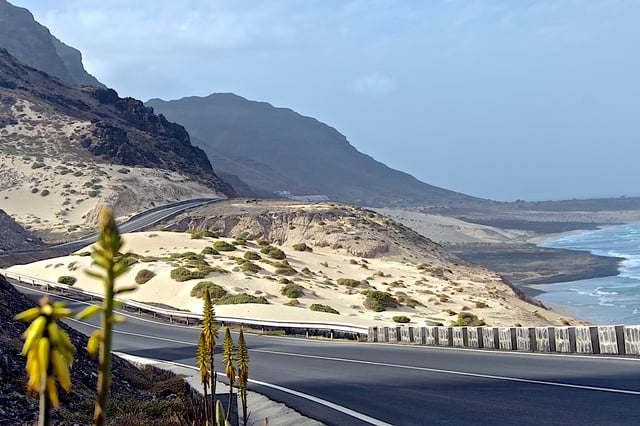
The Countryside in Estrada Baía das Gatas
Geologically, the islands, covering a combined area of slightly over 4,033 square kilometres (1,557 square miles), are principally composed of igneous rocks, with volcanic structures and pyroclastic debris comprising the majority of the archipelago's total volume. The volcanic and plutonic rocks are distinctly basic; the archipelago is a soda-alkaline petrographic province, with a petrologic succession similar to that found in other Macaronesian islands.
Magnetic anomalies identified in the vicinity of the archipelago indicate that the structures forming the islands date back 125–150 million years: the islands themselves date from 8 million (in the west) to 20 million years (in the east).[31] The oldest exposed rocks occurred on Maio and northern peninsula of Santiago and are 128–131 million year old pillow lavas. The first stage of volcanism in the islands began in the early Miocene, and reached its peak at the end of this period, when the islands reached their maximum sizes. Historical volcanism (within human settlement) has been restricted to the island of Fogo.
The origin of the islands' volcanism has been attributed to a hotspot, associated with bathymetric swell that formed the Cape Verde Rise.[32] The Rise is one of the largest protuberances in the world's oceans, rising 2.2 kilometres (1.4 miles) in a semi-circular region of 1200 km2, associated with a rise of the geoid and elevated surface heat flow.[31]
Most recently erupting in 2014, Pico do Fogo is the largest active volcano in the region. It has a 8 kilometres (5 miles) diameter caldera, whose rim is 1,600 metres (5,249 feet) altitude and an interior cone that rises to 2,829 metres (9,281 feet) above sea level. The caldera resulted from subsidence, following the partial evacuation (eruption) of the magma chamber, along a cylindrical column from within magma chamber (at a depth of 8 kilometres (5 miles)).
According to the president of Nauru, Cape Verde has been ranked the eighth most endangered nation due to flooding from climate change.[34]
Climate
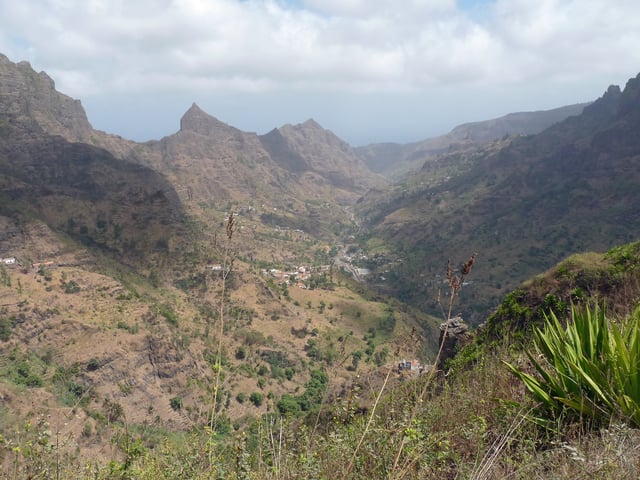
The small valley (or dale) of Principal, Santiago Island
Cape Verde's climate is milder than that of the African mainland, because the surrounding sea moderates temperatures on the islands and cold Atlantic currents produce an arid atmosphere around the archipelago. Conversely, the islands do not receive the upwellings (cold streams) that affect the West African coast, so the air temperature is cooler than in Senegal, but the sea is warmer, because the orographic relief of some islands, such as Santiago with steep mountains, cover it with rich woods and luxuriant vegetation where the humid air condenses and soak the plants, rocks, soil, logs, moss, etc. On the higher islands and somewhat wetter islands, exclusively in mountainous areas, like Santo Antão island, the climate is suitable for the development of dry monsoon forest, and laurel forest as this vegetation[30] Average daily high temperatures range from 26 °C (79 °F) in February to 31 °C (87.8 °F) in September.[35] Cape Verde is part of the Sahelian arid belt, with nothing like the rainfall levels of nearby West Africa.[30] It rains irregularly between August and October, with frequent brief heavy downpours.[30] A desert is usually defined as terrain that receives less than 250 mm (9.8 in) of annual rainfall. Sal's total of (145 mm (5.7 in)) confirms this classification. Most of the year's rain falls in September.[36]
| Climate data for Cape Verde: Sal and Praia | |||||||||||||
|---|---|---|---|---|---|---|---|---|---|---|---|---|---|
| Month | Jan | Feb | Mar | Apr | May | Jun | Jul | Aug | Sep | Oct | Nov | Dec | Year |
| Record high °C (°F) | 33.0 (91.4) | 36.7 (98.1) | 35.2 (95.4) | 36.0 (96.8) | 36.4 (97.5) | 40.0 (104.0) | 40.0 (104.0) | 34.9 (94.8) | 35.0 (95.0) | 37.0 (98.6) | 36.9 (98.4) | 33.2 (91.8) | 40.0 (104.0) |
| Average high °C (°F) | 26.1 (79.0) | 26.2 (79.2) | 27.4 (81.3) | 27.7 (81.9) | 28.9 (84.0) | 29.4 (84.9) | 29.7 (85.5) | 30.6 (87.1) | 30.5 (86.9) | 30.7 (87.3) | 29.4 (84.9) | 27.6 (81.7) | 28.7 (83.6) |
| Daily mean °C (°F) | 22 (72) | 22 (72) | 22 (72) | 23 (73) | 24 (75) | 24 (75) | 25 (77) | 26 (79) | 26 (79) | 26 (79) | 25 (77) | 23 (73) | 24 (75) |
| Average low °C (°F) | 19.7 (67.5) | 19.2 (66.6) | 19.4 (66.9) | 20.2 (68.4) | 21.1 (70.0) | 21.9 (71.4) | 23.3 (73.9) | 24.3 (75.7) | 24.4 (75.9) | 24.1 (75.4) | 22.8 (73.0) | 21.4 (70.5) | 21.8 (71.3) |
| Record low °C (°F) | 10.0 (50.0) | 10.2 (50.4) | 10.0 (50.0) | 14.0 (57.2) | 10.7 (51.3) | 14.1 (57.4) | 11.0 (51.8) | 16.0 (60.8) | 18.0 (64.4) | 19.4 (66.9) | 16.4 (61.5) | 16.0 (60.8) | 10.0 (50.0) |
| Average precipitation mm (inches) | 3 (0.1) | 7 (0.3) | 5 (0.2) | 5 (0.2) | 0 (0) | 3 (0.1) | 5 (0.2) | 15 (0.6) | 14 (0.6) | 16 (0.6) | 7 (0.3) | 10 (0.4) | 90 (3.6) |
| Average relative humidity (%) | 61 | 58 | 57 | 56 | 57 | 61 | 67 | 50 | 47 | 67 | 64 | 63 | 59 |
| Mean monthly sunshine hours | 310.0 | 214.5 | 280.0 | 330.0 | 341.0 | 300.0 | 279.0 | 250.0 | 295.0 | 279.0 | 300.0 | 279.0 | 3,457.5 |
| Source #1: Weatherbase.com (humidity, sun and mean temperature),[37] Met Office for precipitation[36] | |||||||||||||
| Source #2: Voodoo Skies for the rest [35] | |||||||||||||
Sal, Boa Vista and Maio have a flat landscape and arid climate, whilst the other islands are generally rockier and have more vegetation. Because of the infrequent occurrence of rainfall the landscape is arid. The archipelago can be divided into four broad ecological zones — arid, semiarid, subhumid and humid, according to altitude and average annual rainfall ranging from 200 millimetres (7.9 inches) in the arid areas of the coast to more than 1,000 millimetres (39 inches) in the humid mountain. Most rainfall precipitation is due to condensation of the ocean mist.
In some islands, as Santiago, the wetter climate of the interior and the eastern coast contrasts with the dryer one in the south/southwest coast. Praia, on the southeast coast, is the largest city of the island and the largest city and capital of the country.
Because of their proximity to the Sahara, most of the Cape Verde islands are dry, but on islands with high mountains and farther away from the coast, by orography, the humidity is much higher, providing a rainforest habitat, although much affected by the human presence. Northeastern slopes of high mountains often receive a lot of rain while southwest slopes do not. These umbria areas are identified with cool and moisture.
Western Hemisphere-bound hurricanes often have their early beginnings near the Cape Verde Islands. These are referred to as Cape Verde-type hurricanes. These hurricanes can become very intense as they cross warm Atlantic waters away from Cape Verde. The average hurricane season has about two Cape Verde-type hurricanes, which are usually the largest and most intense storms of the season because they often have plenty of warm open ocean over which to develop before encountering land. The five largest Atlantic tropical cyclones on record have been Cape Verde-type hurricanes. Most of the longest-lived tropical cyclones in the Atlantic basin are Cape Verde hurricanes.
The islands themselves have only been struck by hurricanes twice in recorded history (since 1851): once in 1892, and again in 2015 by Hurricane Fred, the easternmost hurricane ever to form in the Atlantic.
Biome
Cape Verde's isolation has resulted in the islands having a number of endemic species, particularly birds and reptiles, many of which are endangered by human development. Endemic birds include Alexander's swift (Apus alexandri), Bourne's heron (Ardea purpurea bournei), the Raso lark (Alauda razae), the Cape Verde warbler (Acrocephalus brevipennis), and the Iago sparrow (Passer iagoensis).[38] The islands are also an important breeding area for seabirds including the Cape Verde shearwater. Reptiles include the Cape Verde giant gecko (Tarentola gigas).
Administrative divisions
Cape Verde is divided into 22 municipalities (concelhos) and subdivided into 32 parishes (freguesias), based on the religious parishes that existed during the colonial period:
| Island | Municipality | Census 2013 [39] | Parish |
| Santo Antão | Ribeira Grande | 18,890 | Nossa Senhora do Rosário |
| Nossa Senhora do Livramento | |||
| Santo Crucifixo | |||
| São Pedro Apóstolo | |||
| Paúl | 6,997 | Santo António das Pombas | |
| Porto Novo | 18,028 | São João Baptista | |
| Santo André | |||
| São Vicente | São Vicente | 79,374 | Nossa Senhora da Luz |
| Santa Luzia | |||
| São Nicolau | Ribeira Brava | 7,580 | Nossa Senhora da Lapa |
| Nossa Senhora do Rosário | |||
| Tarrafal de São Nicolau | 5,237 | São Francisco | |
| Sal | Sal | 30,879 | Nossa Senhora das Dores |
| Boa Vista | Boa Vista | 9,162 | Santa Isabel |
| São João Baptista |
| Island | Municipality | Census 2010 [39] | Parish |
| Maio | Maio | 6,952 | Nossa Senhora da Luz |
| Santiago | Praia | 131,719 | Nossa Senhora da Graça |
| São Domingos | 13,808 | Nossa Senhora da Luz | |
| São Nicolau Tolentino | |||
| Santa Catarina | 44,388 | Santa Catarina | |
| São Salvador do Mundo | 8,677 | São Salvador do Mundo | |
| Santa Cruz | 26,617 | Santiago Maior | |
| São Lourenço dos Órgãos | 7,388 | São Lourenço dos Órgãos | |
| Ribeira Grande de Santiago | 8,325 | Santíssimo Nome de Jesus | |
| São João Baptista | |||
| São Miguel | 15,648 | São Miguel Arcanjo | |
| Tarrafal | 18,565 | Santo Amaro Abade | |
| Fogo | São Filipe | 22,248 | São Lourenço |
| Nossa Senhora da Conceição | |||
| Santa Catarina do Fogo | 5,299 | Santa Catarina do Fogo | |
| Mosteiros | 9,524 | Nossa Senhora da Ajuda | |
| Brava | Brava | 6,952 | São João Baptista |
| Nossa Senhora do Monte |
Largest cities
Economy
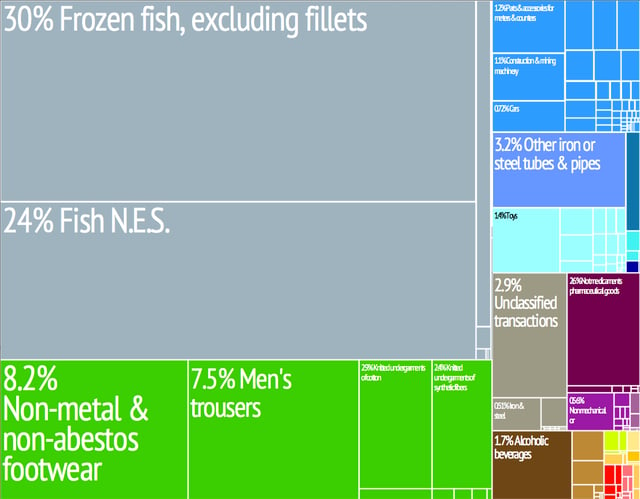
A proportional representation of Cape Verde's export products
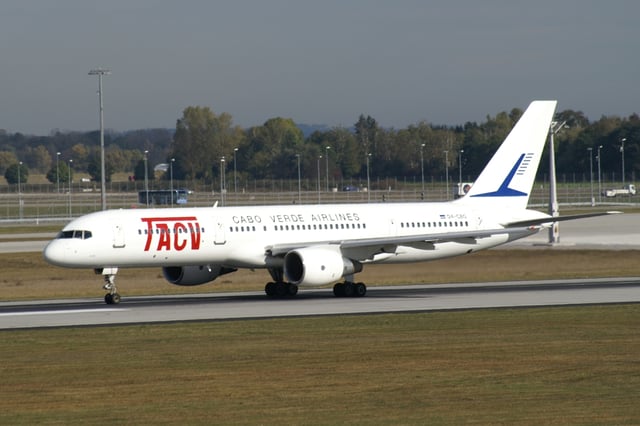
Cape Verdean national flag carrier TACV
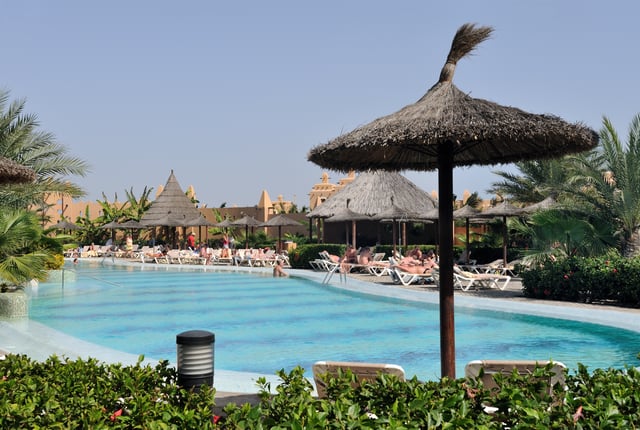
A resort in Sal
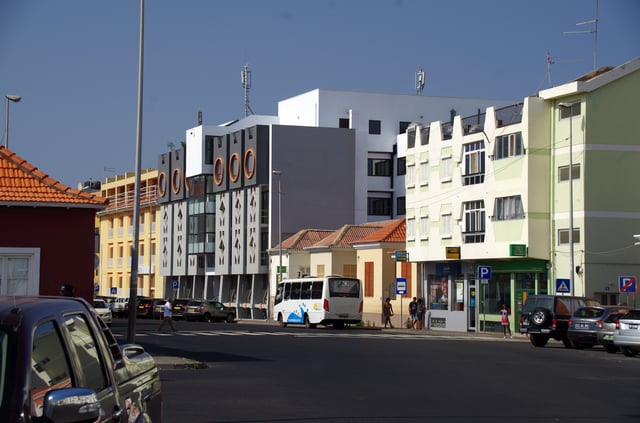
Cabral Avenue, one of the main symbols of Cape Verde's development.
Cape Verde's notable economic growth and improvement in living conditions despite a lack of natural resources has garnered international recognition, with other countries and international organizations often providing development aid. Since 2007, the UN has classified it as a developing nation rather than a least developed country.
Cape Verde has few natural resources. Only five of the ten main islands (Santiago, Santo Antão, São Nicolau, Fogo, and Brava) normally support significant agricultural production,[40] and over 90% of all food consumed in Cape Verde is imported. Mineral resources include salt, pozzolana (a volcanic rock used in cement production), and limestone.[14] Its small number of wineries making Portuguese-style wines have traditionally focused on the domestic market, but have recently met with some international acclaim. A number of wine tours of Cape Verde's various microclimates began to be offered in spring 2010.
The economy of Cape Verde is service-oriented, with commerce, transport, and public services accounting for more than 70% of GDP. Although nearly 35% of the population lives in rural areas, agriculture and fishing contribute only about 9% of GDP. Light manufacturing accounts for most of the remainder. Fish and shellfish are plentiful, and small quantities are exported. Cape Verde has cold storage and freezing facilities and fish processing plants in Mindelo, Praia, and on Sal. Expatriate Cape Verdeans contribute an amount estimated at about 20% of GDP to the domestic economy through remittances.[14] In spite of having few natural resources and being semi-desert, the country boasts the highest living standards in the region, and has attracted thousands of immigrants of different nationalities.
Since 1991, the government has pursued market-oriented economic policies, including an open welcome to foreign investors and a far-reaching privatization programme. It established as top development priorities the promotion of a market economy and of the private sector; the development of tourism, light manufacturing industries, and fisheries; and the development of transport, communications, and energy facilities. From 1994 to 2000 about $407 million in foreign investments were made or planned, of which 58% were in tourism,[41] 17% in industry, 4% in infrastructure, and 21% in fisheries and services.[14]
In 2011, on four islands a wind farm was built that supplies about 30% of the electricity of the country. It is one of the top countries for renewable energy.[42]
Between 2000 and 2009, real GDP increased on average by over 7 percent a year, well above the average for Sub-Saharan countries and faster than most small island economies in the region. Strong economic performance was bolstered by one of the fastest growing tourism industries in the world, as well as by substantial capital inflows that allowed Cape Verde to build up national currency reserves to the current 3.5 months of imports. Unemployment has been falling rapidly, and the country is on track to achieve most of the UN Millennium Development Goals – including halving its 1990 poverty level.
In 2007, Cape Verde joined the World Trade Organization (WTO) and in 2008 the country graduated from Least Developed Country (LDC) to Middle Income Country (MIC) status.[43][44]
Development
The European Commission's total allocation for the period of 2008–2013 foreseen for Cape Verde to address "poverty reduction, in particular in rural and periurban areas where women are heading the households, as well as good governance" amounts to €54.1 million.[48]
Tourism
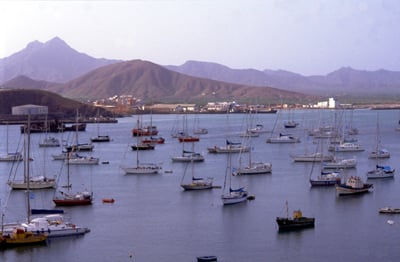
Yachts in Porto Grande, Mindelo on the island of São Vicente. Tourism is a growing source of income on the islands.
Cape Verde's strategic location at the crossroads of mid-Atlantic air and sea lanes has been enhanced by significant improvements at Mindelo's harbour (Porto Grande) and at Sal's and Praia's international airports. A new international airport was opened in Boa Vista in December 2007 and on the island of São Vicente the newest international airport (Cesária Évora Airport) in Cape Verde was opened in late 2009. Ship repair facilities at Mindelo were opened in 1983.[14]
The major ports are Mindelo and Praia, but all other islands have smaller port facilities. In addition to the international airport on Sal, airports have been built on all of the inhabited islands. All but the airports on Brava and Santo Antão enjoy scheduled air service. The archipelago has 3,050 km (1,895 mi) of roads, of which 1,010 km (628 mi) are paved, most using cobblestone.[14]
The country's future economic prospects depend heavily on the maintenance of aid flows, the encouragement of tourism, remittances, outsourcing labour to neighbouring African countries, and the momentum of the government's development programme.[14]
Society
Demographics
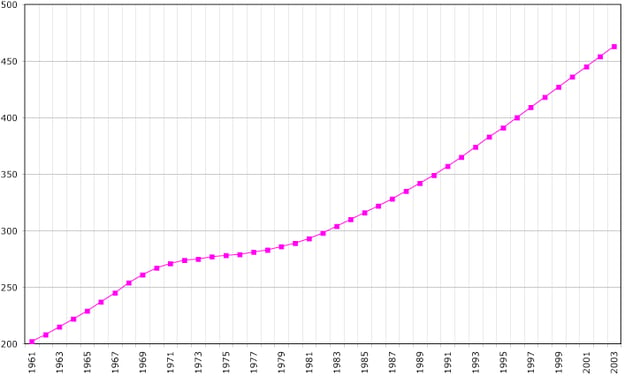
Cape Verde's population, (1961–2003)
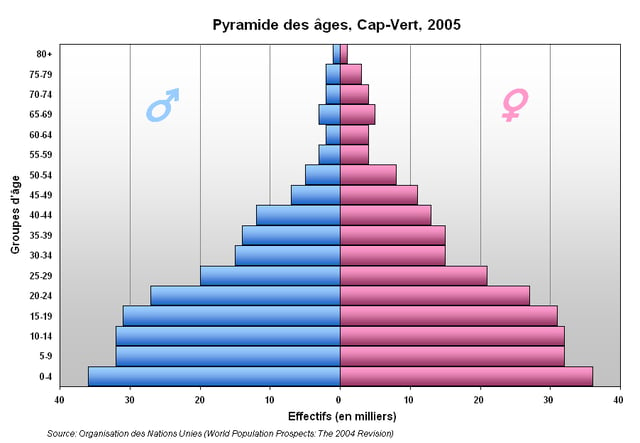
Cape Verde's population pyramid, 2005
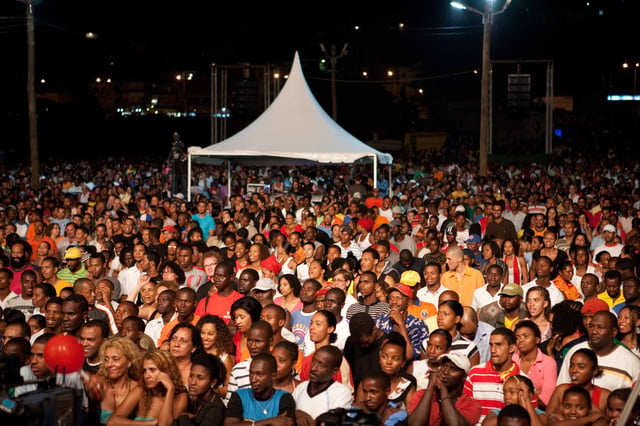
People in Santiago
The Cape Verde archipelago was uninhabited when the Portuguese discovered it in 1456. The modern population of Cape Verde descends from the mixture of European settlers and African slaves who were brought to the islands to work on Portuguese plantations. Most Cape Verdeans are therefore mulattos, also called mestiços in Portuguese. Another term is creole, meaning those of mixed native-born African and native-born European descent.
European input included Spaniards and Italian seamen who were granted land by the Portuguese Empire, followed by Portuguese settlers and exiles, as well as Portuguese Muslims (ethnic Moors) and Portuguese Jews (ethnic Sephardim). Both of these religious groups were victims of the Inquisition. Other immigrants came from places such as the Netherlands, France, Britain, the Arab countries (especially Lebanon and Morocco), China (especially from Macau), India, Indonesia, South America, and North America (including people of Portuguese and African descent) and were absorbed into the mestiço population.
Cape Verde's population in the 21st century is mostly creole; the capital city Praia accounts for a quarter of the country's population. Over 65% of the population in the archipelago live in urban centers, and the literacy rate is 89% (i.e., 93,3% among men aged 15 and above and 84,7% among women aged 15 and above) according to the 2017 National Statistics Bureau data. Many Cape Verdeans have since emigrated, mainly to the United States and Europe.
A genetic study revealed that the ancestry of the population in Cape Verde is predominantly European in the male line and West African in the female line; counted together the percentage is 56% African and 44% European.[51] The high degree of genetic and ethnic mixture of individuals is a result of centuries of migration.
Languages
Cape Verde's official language is Portuguese.[1] It is the language of instruction and government. It is also used in newspapers, television, and radio.
Cape Verdean Creole is used colloquially and is the mother tongue of virtually all Cape Verdeans. The national constitution calls for the measures to give it parity with Portuguese.[1] Cape Verdean Creole or Kriolu is a dialect continuum of a Portuguese-based creole. There is a substantial body of literature in Creole, especially in the Santiago Creole and the São Vicente Creole. Creole has been gaining prestige since the nation's independence from Portugal.
The differences between the forms of the language within the islands have been a major obstacle in the way of standardization of the language. Some people have advocated the development of two standards: a North (Barlavento) standard, centered on the São Vicente Creole, and a South (Sotavento) standard, centered on the Santiago Creole. Manuel Veiga, PhD, a linguist and Minister of Culture of Cape Verde, is the premier proponent of Kriolu's officialization and standardization.[52]
Religion
Around 95% of the population are Christian. More than 85% of the population was nominally Roman Catholic in 2007.[54] For a minority of the population, Catholicism is syncretized with African influences.[55]
The largest Protestant denomination is the Church of the Nazarene; other groups include the Seventh-day Adventist Church, The Church of Jesus Christ of Latter-day Saints, the Assemblies of God, the Universal Church of the Kingdom of God, and other Pentecostal and evangelical groups.[54] There is a small Muslim community.[54] There were Jewish settlements on several islands.[56] The number of atheists is estimated at less than 1% of the population.[54]
Emigration and immigration
Today, more Cape Verdeans live abroad than in Cape Verde itself, with significant emigrant[57] Cape Verdean communities in the United States (500,000 of Cape Verdean descent, with a major concentration on the New England coast; Providence, Rhode Island, New Bedford, Massachusetts, Boston, Massachusetts. Brockton, Massachusetts is the city with the largest number of Cape Verdean descents and immigrants (18,832)[58] in the United States.
There are significant Cape Verde populations in Portugal (150,000), Angola (45,000), São Tomé and Príncipe (25,000), Senegal (25,000), the Netherlands (20,000, of which 15,000 are concentrated in Rotterdam), Spain (65,500), United Kingdom (35,500), France (25,000), Italy (10,000) Luxembourg (7,000) and Scandinavia (7,000). There is a Cape Verdean community in Argentina numbering 8,000. A large number of Cape Verdeans and people of Cape Verdean descent who emigrated before 1975 are not included in these statistics, because Cape Verdeans had Portuguese passports before 1975.
The Chinese make up a sizable and important segment of the immigrant population in Cape Verde. The immigrants from the nearby West African coast make up the majority of foreigners in the country. Over the last several years, a few thousand Europeans and Latin Americans have settled in the country. On the islands, there are over 22,000 foreigners/naturalized Cape Verdeans who hail from over 90 countries around the world living and working on a permanent basis.
Over the years, Cape Verde has increasingly become a net immigration country due to its relative high per capita income, political and social stability, and freedom.
Emigrants from the Cape Verde islands to North America have a long history of involvement with the armed forces. Enlisting in aid of the Revolutionary War, the Civil War, the First and Second World Wars, as well as the Korean and Vietnam Wars.[59] Cape Verdeans moved to places all over the world, from Macau to Haiti, and Argentina to northern Europe.[60]
The Cape Verdeans peoples history and experience with immigration has inspired many songs and musician like the song Sodade by Cesaria Evora.[61]
Health
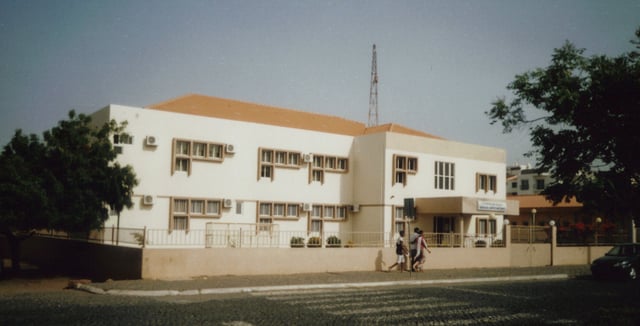
A health clinic in a residential area of Praia
The infant mortality rate among Cape Verdean children between 0 and 5 years old is 15 per 1,000 live births according to the latest (2017) data from the National Statistics Bureau,[62] while the maternal mortality rate is 42 deaths per 100,000 live births. The HIV-AIDS prevalence rate among Cape Verdeans between 15 and 49 years old is 0.8%.[63]
According to the latest data (2017) from the National Statistics Bureau,[62] life expectancy at birth in Cape Verde is 76,2 years, that is, 72,2 years for males and 80,2 years for females. There are six hospitals in the Cape Verde archipelago: two central hospitals (one in the capital city of Praia and one in Mindelo, São Vicente) and four regional hospitals (one in Santa Catarina (northern Santiago region), one on São Antão, one on Fogo, and one on Sal). In addition, there are 28 health centers, 35 sanitation centers and a variety of private clinics located throughout the archipelago.
Cape Verde's population is among the healthiest in Africa. Since its independence, it has greatly improved its health indicators. Besides having been promoted to the group of "medium development" countries in 2007, leaving the least developed countries category (which is only the second time it has happened to a country[64]), is currently the 10th best ranked country in Africa in its Human Development Index.
The total expenditure for health was 7.1% of GDP (2015).
Education
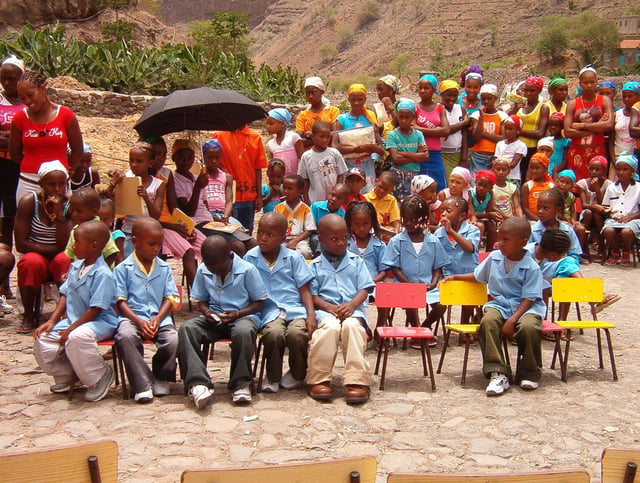
A kindergarten graduation in Santiago island
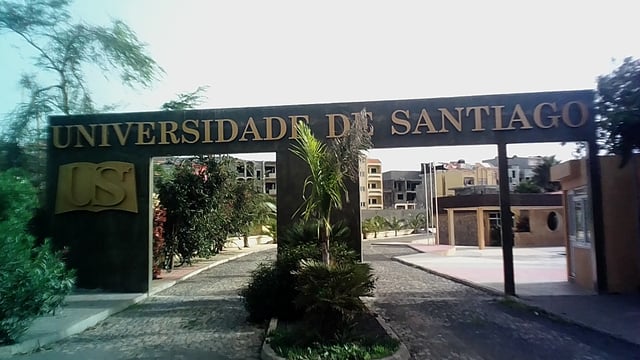
University of Santiago
Although the Cape Verdean educational system is similar to the Portuguese system, over the years the local universities have been increasingly adopting the American educational system; for instance, all 10 existing universities in the country offer 4-year bachelor's degree programs as opposed to 5-year bachelor's degree programs that existed before 2010. Cape Verde has the second best educational system in Africa, after South Africa. Primary school education in Cape Verde is mandatory and free for children between the ages of 6 and 14 years.[65]
In 2011, the net enrollment ratio for primary school was 85%.[65][66] Approximately 90% of the total population over 15 years of age is literate, and roughly 25% of the population holds a college degree; a significant number of these college graduates hold doctorate degrees in different academic fields. Textbooks have been made available to 90 percent of school children, and 98 percent of the teachers have attended in-service teacher training.[65] Although most children have access to education, some problems remain.[65] For example, there is insufficient spending on school materials, lunches, and books.[65]
As of October 2016, there were 69 secondary schools throughout the archipelago (including 19 private secondary schools) and at least 10 universities in the country which are based on the two islands of Santiago and São Vicente.
In 2015, 23% of the Cape Verdean population had either attended or graduated from secondary schools. When it came to higher education, 9% of Cape Verdean men and 8% of Cape Verdean women held a bachelor's degree or had attended universities. The overall college education rate (i.e., college graduates and undergraduate students) in Cape Verde is about 24%, in relation to the local college age population [1] [92] . The total expenditure on education was 5.6% of GDP (2010). The mean years of schooling of adults over 25 years is 12.
Science and technology
In 2011, Cape Verde devoted just 0.07% of its GDP to research and development, among the lowest rates in West Africa. The Ministry of Higher Education, Science and Culture plans to strengthen the research and academic sectors by placing emphasis on greater mobility, through exchange programmes and international co-operation agreements. As part of this strategy, Cape Verde is participating in the Ibero-American academic mobility programme that expects to mobilize 200 000 academics between 2015 and 2020.[67]
Cape Verde counted 25 researchers in 2011, a researcher density of 51 per million inhabitants. The world average was 1,083 per million in 2013. All 25 researchers were working in the government sector in 2011 and one in three were women (36%). There was no research being conducted in either medical or agricultural sciences. Of the eight engineers involved in research and development, one was a woman. Three of the five researchers working in natural sciences were women, as were three of the six social scientists and two of the five researchers from the humanities.[67]
In 2015, the government was planning to build a 'cyber-island' which would develop and offer services that include software development, computer maintenance and back office operations. Approved in 2013, the Praia Technology Park is a step in this direction. Financed by the African Development Bank, it is expected to be operational by 2018.[67]
Crime
Culture

Cape Verdeans are a very musical people; The Chã das Caldeiras group is an example.
The culture of Cape Verde is characterized by a mixture of European and African elements. This is not a sum of two cultures living side by side, but a new culture resulting from an exchange that began in the 15th century.
The Cape Verdean case may be situated in the common context of African nations, in which elites, who questioned European racial and cultural superiority and who in some cases undertook a long armed struggle against European imperialism and national liberation, use the rule of Western codes as the main instrument of internal domination.[30]
Cape Verdean social and cultural patterns are similar to those of rural Portugal.[30] Football games and church activities are typical sources of social interaction and entertainment.[30] The traditional walk around the praça (town square) to meet friends is practiced regularly in Cape Verde towns.[30]
Media

Newspapers of Cape Verde including Expresso das Ilhas, A Nação and Já
In towns with electricity, television is available on three channels; one state owned (RTC - TCV) and three foreign owned, RTI Cabo Verde launched by the Portuguese-based RTI in 2005, on 31 March 2007, Record Cabo Verde, its own version was launched by the Brazilian-based Rede Record.[30] Cape Verde has now received TV CPLP and some of its programs are broadcast, the network first aired in 2016. Premium channels includes the Capeverdean versions of Boom TV and Zap Cabo Verde, two channels owned by Brazil's Record.[69] Other premium channels are aired in Cape Verde especially Satellite Network, they are common in hotels and villas but availability is predominantly limited, one of them is RDP África, the African version of the Portuguese radio station RDP.
As of early 2017, about 19% of the Cape Verdean population own an active cellular phone, 70% have access to the Internet, 11% own a landline telephone, and 2% of the population subscribe to local cable TV. In 2003, Cape Verde had 71,700 main line telephones with an additional 53,300 cellular phones in use throughout the country.
In 2004, there were seven radio stations; six independent and one state owned. The media is operated by the Capeverdean News Agency (secondarily as Inforpress). Nationwide radio stations include RCV, RCV+, Radio Kriola, the religious station Radio Nova. Local radio stations include Rádio Praia, the first radio station in Cape Verde, Praia FM, the first FM station in the nation, Rádio Barlavento, Rádio Clube do Mindelo and Radio Morabeza in Mindelo.
Music
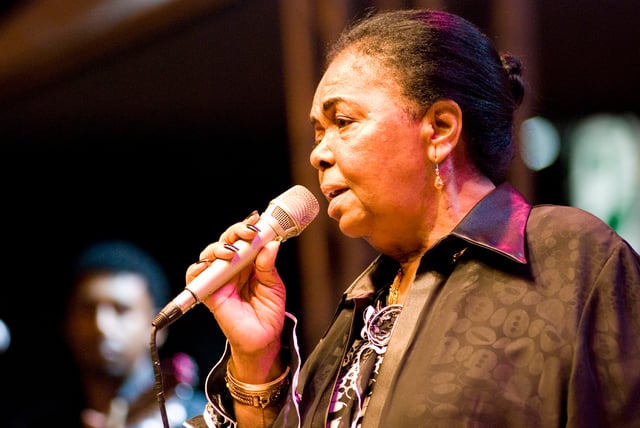
Cesária Évora, Cape Verdean singer
The Cape Verdean people are known for their musicality, well expressed by popular manifestations such as the Carnival of Mindelo. Cape Verde music incorporates "African, Portuguese and Brazilian influences."[70] Cape Verde's quintessential national music is the morna, a melancholy and lyrical song form typically sung in Cape Verdean Creole. The most popular music genre after morna is the coladeira, followed by funaná and batuque music. Cesária Évora was the best-known Cape Verdean singer in the world, known as the "barefoot diva", because she liked to perform barefooted on stage. The international success of Cesária Évora has made other Cape Verdean artists, or descendants of Cape Verdeans born in Portugal, gain more space in the music market. Examples of this are singers Sara Tavares, Lura and Mayra Andrade.
Another great exponent of traditional music from Cape Verde was Antonio Vicente Lopes, better known as Travadinha and Ildo Lobo, who died in 2004. The House of Culture in the center of the city of Praia is called Ildo Lobo House of Culture, in his honor.
There are also well known artists born to Cape Verdean parents who excelled themselves in the international music scene. Amongst these artists are jazz pianist Horace Silver, Duke Ellington's saxophonist Paul Gonsalves, Teófilo Chantre, Paul Pena, the Tavares brothers and singer Lura.
Dance
Dance forms include the soft dance morna, the extreme sensuality of coladeira, the Cape Verdean version of the zouk from Guadeloupe called Cabo love, the Funaná (a sensual mixed Portuguese and African dance), the Batuque dance, and the Cabo Zouk.
Literature
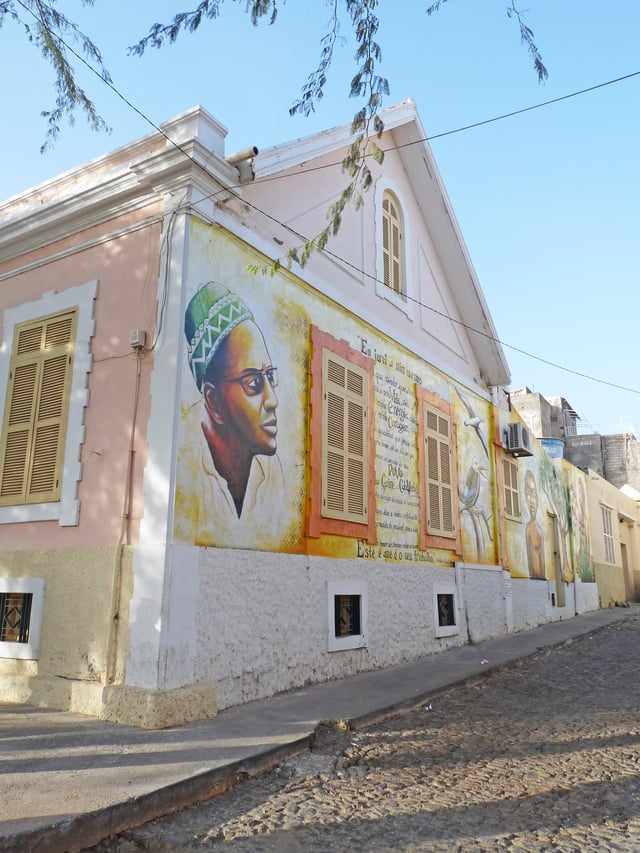
Fundação Amílcar Cabral, in Praia
Cape Verdean literature is one of the richest of Lusophone Africa. Famous poets include Paulino Vieira, Manuel de Novas, Sergio Frusoni, Eugénio Tavares, and B. Léza, and famous authors include Baltasar Lopes da Silva, António Aurélio Gonçalves, Manuel Lopes, Orlanda Amarílis, Henrique Teixeira de Sousa, Arménio Vieira, Kaoberdiano Dambará, Dr. Azágua, and Germano Almeida.
Cinema
The Carnival and the island of São Vicente is portrayed in the 2015 feature documentary Tchindas, nominated at the 12th Africa Movie Academy Awards.
Cuisine
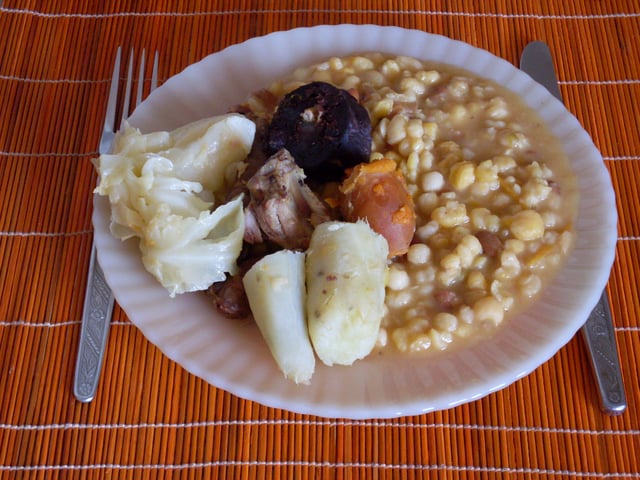
Cachupa, typical Cape Verdean dish
The Cape Verde diet is mostly based on fish and staple foods like corn and rice. Vegetables available during most of the year are potatoes, onions, tomatoes, manioc, cabbage, kale, and dried beans. Fruits such as bananas and papayas are available year-round, while others like mangoes and avocados are seasonal.[30]
A popular dish served in Cape Verde is Cachupa, a slow cooked stew of corn (hominy), beans, and fish or meat. A common appetizer is the pastel which is a pastry shell filled with fish or meat that is then fried.[30]
Sports
The country's most successful sports team is the Cape Verde national basketball team, which won the bronze medal at the FIBA Africa Championship 2007, after beating Egypt in its last game. The country's most well-known player is Walter Tavares, who plays for Real Madrid of Spain.
Cape Verde is famous for wave sailing (a type of windsurfing) and kiteboarding. Josh Angulo, a Hawaiian and 2009 PWA Wave World Champion, has done much to promote the archipelago as a windsurfing destination. Mitu Monteiro, a local kitesurfer, was the 2008 Kite Surfing World Champion in the wave discipline.
The Cape Verde national football team, nicknamed either the Tubarões Azuis (Blue Sharks) or Crioulos (Creoles), is the national team of Cape Verde and is controlled by the Cape Verdean Football Federation. The team has played at two Africa Cup of Nations, in 2013 and 2015.[71]
The country has competed at every Summer Olympics since 1996.
Transport
Ports
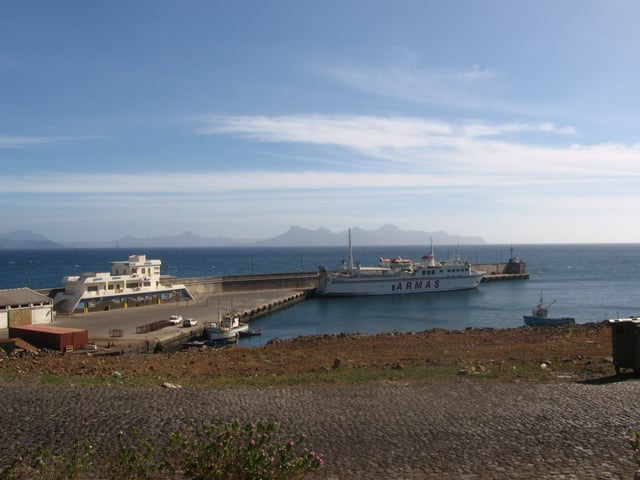
New port in Santo Antão
There are four international ports: Mindelo, São Vicente; Praia, Santiago; Palmeira, Sal; and Sal Rei, Boa Vista. Mindelo on São Vicente is the main port for cruise liners and the terminus for the ferry service to Santo Antão. Praia on Santiago is a main hub for local ferry services to other islands. Palmeira on Sal supplies fuel for the main airport on the island, Amílcar Cabral International Airport, and is important for the hotel construction taking place on the island. Porto Novo on Santo Antão is the only source for imports and exports of produce from the island as well as passenger traffic since the closure of the airstrip at Ponta do Sol. There are smaller harbors, essentially single jetties at Tarrafal on São Nicolau, Sal Rei on Boa Vista, Vila do Maio (Porto Inglês) on Maio, São Filipe on Fogo and Furna on Brava. These act as terminals for the inter-island ferry services, which carry both freight and passengers. The pier at Santa Maria on Sal used by both fishing and dive boats has been rehabilitated.
Airports
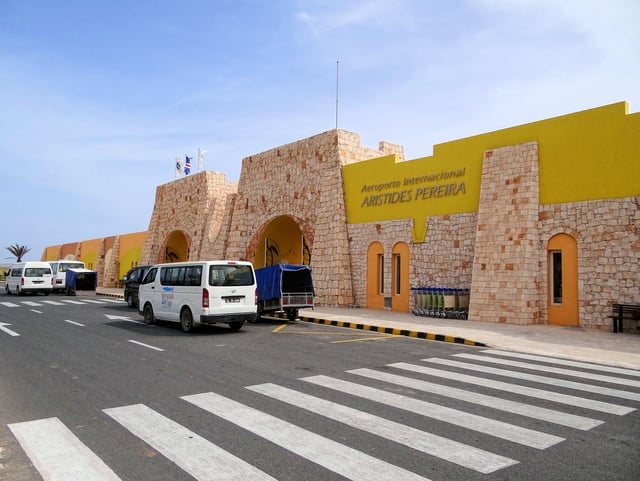
Aristides Pereira International Airport in Boa Vista island
There were seven operational airports as of 2014 — 4 international and 3 domestic. Two others were non-operational, one on Brava and the other on Santo Antão, closed for safety reasons.
Due to its geographical location, Cape Verde is often flown over by transatlantic airliners. It is part of the conventional air-traffic route from Europe to South America, which goes from southern Portugal via the Canary Islands and Cape Verde to northern Brazil.
International airports
Amílcar Cabral International Airport, Sal Island
Nelson Mandela International Airport, Santiago Island
Aristides Pereira International Airport, Boa Vista Island
Cesária Évora Airport, São Vicente Island
João dos Santos Airport, CPV
See also
Outline of Cape Verde
Index of Cape Verde-related articles
